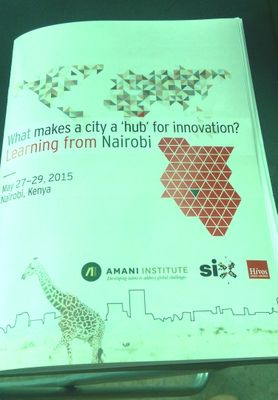Innovation often springs from connections and exchange of ideas. Cities by their very nature - bringing together diverse communities - provide fertile ground for collaboration. This is increasingly true in the Global South where the complex environment of city life provides challenges turned into opportunities by budding innovators.
“What makes a city a ‘hub’ for innovation? Learning from Nairobi” was a three-day event hosted by the Social Innovation Exchange and Amani institute with support from Hivos on May 27th – 29th 2015. This event brought together 100 participants from across the world to think through what constitutes an innovation ecosystem and the roles cities play in this.
Nairobi has quickly established itself as a leading African innovation center and the program aimed at exploring different initiatives going on in Nairobi while drawing lessons from other cities. The conference kicked off with the 3rd annual FailFaire where five speakers shared their stories of failure both at a personal and organizational level. One of the fantastic takeaways from this session was the ability of each organization to see failure as an integral part of its learning and growth. Innovators in the Innovations in Healthcare network take the same view to failure as summarized in this paper on Smart Failure.
What can cities do to make sure learning is shared and social innovation is cultivated?
This was the question that participants grappled with in a day that included panel sessions, presentations from across the world and site visits to experience the faces and spaces of Nairobi’s innovation ecosystem. To become a hub for innovation, cities need to recognize constraints to innovation and design activities that foster social innovation. This requires collaboration among various ecosystem actors including governments, innovators and organizations that support scaling of innovation. Beyond planning, the “doing” portion involves linking social innovators and policy while allowing ideas developed from the ground up. This mix illustrates the need for hubs and similar spaces that act as focal points for change as well as the importance of harnessing the diversity that is an implicit characteristic of most large cities.
The examples shared from across the world reinforced this. In Tunis the Cogite co-working space seeks to harness the creativity of Tunisians to contribute to social change. Nsibidi Institute in Lagos, Nigeria works to develop strategies with a citywide impact as they see the challenges of a large city as opportunities for transformation. One project highlighted was Wecyclers that uses bicycles to collect waste in the city and avoid traffic jams. Large universities shape innovation in the cities they are based and increasingly focus on social innovation. BRAC in Dhaka, Bangladesh has established the Social Innovation Lab that works on topics such as scaling innovation and financial inclusion. The DESIS network based in Rio de Janeiro is creating a network of design labs across multiple universities while working in their city to support inclusive public policies that support startups from low-income areas. Organizations that support innovators are also critical to ecosystems. Intellecap shared their experience on scaling business support through a virtual incubation platform in India.
The day ended with site visits to various parts of Nairobi to see the ecosystem in action. The visits included Pawa254 and GoDown Arts Centre which are hubs for designers and artists, iLab at Strathmore University and iHub that bring together technology innovators and a walking tour of Dandora (an informal settlement) to see the work of Placemakers, an organization that fosters collaboration in urban spaces.
What are the invisible conditions of ecosystems?
During the second day of the conference participants reflected on the “invisible” conditions that need to exist for an ecosystem to thrive. Discussion topics included:
- What technological innovation means in the African context
- Using brand thinking to put Nairobi on the innovation map
- Next steps after a successful pilot.
- Thinking like a data scientist
- Using the business model canvas
- Identifying a personal brand
- Engaging multiple stakeholders.
The conference wrapped up with a panel session on integrating inclusive impact into innovation ecosystems. Innovations in Healthcare contributes to inclusive impact through the work of our innovators, including those in the SEAD program.
This was a great opportunity for our East Africa team to connect with others in the Nairobi innovation ecosystem as well as to learn from others working in cities across the world. The Innovations in Healthcare/SEAD East Africa team will soon be sharing key findings from an ecosystem mapping that looks at the health innovation ecosystem in Kenya.
To learn more about how to engage with the Innovations in Healthcare East Africa team and how you can learn more about emerging trends in healthcare innovation in the region, please contact Patricia Odero (patricia.odero@duke.edu) or Sylvia Sable (sylvia.sable@duke.edu).

